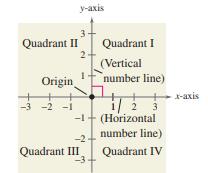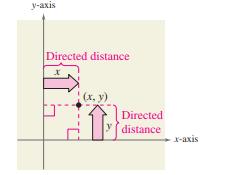
Concept explainers
Write a paragraph that describes a Cartesian plane. Then write a second paragraph that describes how to plot points in the Cartesian plane. Your paragraphs should include the terms “coordinate axes,� “ordered pair,� “coordinates,� “plot,� “ ,� and “ .�
To write: A paragraph that describes a Cartesian plane. Then write a second paragraph that describes how to plot points in the Cartesian plane. Your paragraphs should include the terms “coordinate axes,” “ordered pair,” “coordinates,” “plot,” “,” and “”.
Answer to Problem 68AYU
The Cartesian plane is formed by using two real number lines intersecting at right angles, as shown in Figure. The horizontal real number line is usually called the , and the vertical real number line is usually called the . The point of intersection of these two axes is the origin, and the two axes divide the plane into four parts called quadrants.
Each point in the plane corresponds to an ordered pair of real numbers and called coordinates of the point. The represents the directed distance from the -axis to the point, and the represents the directed distance from the -axis to the point, as shown in Figure.
Explanation of Solution
The Cartesian plane is formed by using two real number lines intersecting at right angles, as shown in Figure. The horizontal real number line is usually called the , and the vertical real number line is usually called the . The point of intersection of these two axes is the origin, and the two axes divide the plane into four parts called quadrants.

Each point in the plane corresponds to an ordered pair of real numbers and called coordinates of the point. The represents the directed distance from the -axis to the point, and the represents the directed distance from the -axis to the point, as shown in Figure.

The notation denotes both a point in the plane and an open interval on the real number line.
Chapter 1 Solutions
Precalculus
Additional Math Textbook Solutions
Intro Stats, Books a la Carte Edition (5th Edition)
Pre-Algebra Student Edition
Introductory Statistics
Calculus: Early Transcendentals (2nd Edition)
Elementary Statistics
Thinking Mathematically (6th Edition)
- Consider the function f(x) = x²-1. (a) Find the instantaneous rate of change of f(x) at x=1 using the definition of the derivative. Show all your steps clearly. (b) Sketch the graph of f(x) around x = 1. Draw the secant line passing through the points on the graph where x 1 and x-> 1+h (for a small positive value of h, illustrate conceptually). Then, draw the tangent line to the graph at x=1. Explain how the slope of the tangent line relates to the value you found in part (a). (c) In a few sentences, explain what the instantaneous rate of change of f(x) at x = 1 represents in the context of the graph of f(x). How does the rate of change of this function vary at different points?arrow_forward1. The graph of ƒ is given. Use the graph to evaluate each of the following values. If a value does not exist, state that fact. и (a) f'(-5) (b) f'(-3) (c) f'(0) (d) f'(5) 2. Find an equation of the tangent line to the graph of y = g(x) at x = 5 if g(5) = −3 and g'(5) = 4. - 3. If an equation of the tangent line to the graph of y = f(x) at the point where x 2 is y = 4x — 5, find ƒ(2) and f'(2).arrow_forwardDoes the series converge or divergearrow_forward
- Suppose that a particle moves along a straight line with velocity v (t) = 62t, where 0 < t <3 (v(t) in meters per second, t in seconds). Find the displacement d (t) at time t and the displacement up to t = 3. d(t) ds = ["v (s) da = { The displacement up to t = 3 is d(3)- meters.arrow_forwardLet f (x) = x², a 3, and b = = 4. Answer exactly. a. Find the average value fave of f between a and b. fave b. Find a point c where f (c) = fave. Enter only one of the possible values for c. c=arrow_forwardplease do Q3arrow_forward
- Use the properties of logarithms, given that In(2) = 0.6931 and In(3) = 1.0986, to approximate the logarithm. Use a calculator to confirm your approximations. (Round your answers to four decimal places.) (a) In(0.75) (b) In(24) (c) In(18) 1 (d) In ≈ 2 72arrow_forwardFind the indefinite integral. (Remember the constant of integration.) √tan(8x) tan(8x) sec²(8x) dxarrow_forwardFind the indefinite integral by making a change of variables. (Remember the constant of integration.) √(x+4) 4)√6-x dxarrow_forward
 Calculus: Early TranscendentalsCalculusISBN:9781285741550Author:James StewartPublisher:Cengage Learning
Calculus: Early TranscendentalsCalculusISBN:9781285741550Author:James StewartPublisher:Cengage Learning Thomas' Calculus (14th Edition)CalculusISBN:9780134438986Author:Joel R. Hass, Christopher E. Heil, Maurice D. WeirPublisher:PEARSON
Thomas' Calculus (14th Edition)CalculusISBN:9780134438986Author:Joel R. Hass, Christopher E. Heil, Maurice D. WeirPublisher:PEARSON Calculus: Early Transcendentals (3rd Edition)CalculusISBN:9780134763644Author:William L. Briggs, Lyle Cochran, Bernard Gillett, Eric SchulzPublisher:PEARSON
Calculus: Early Transcendentals (3rd Edition)CalculusISBN:9780134763644Author:William L. Briggs, Lyle Cochran, Bernard Gillett, Eric SchulzPublisher:PEARSON Calculus: Early TranscendentalsCalculusISBN:9781319050740Author:Jon Rogawski, Colin Adams, Robert FranzosaPublisher:W. H. Freeman
Calculus: Early TranscendentalsCalculusISBN:9781319050740Author:Jon Rogawski, Colin Adams, Robert FranzosaPublisher:W. H. Freeman
 Calculus: Early Transcendental FunctionsCalculusISBN:9781337552516Author:Ron Larson, Bruce H. EdwardsPublisher:Cengage Learning
Calculus: Early Transcendental FunctionsCalculusISBN:9781337552516Author:Ron Larson, Bruce H. EdwardsPublisher:Cengage Learning





